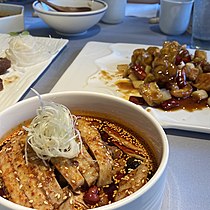Culture of Sichuan and nearby parts of China
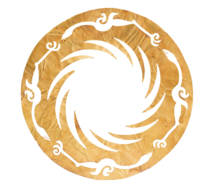
Ba-Shu culture (Chinese: 巴蜀文化; pinyin: Bāshǔ wénhuà) refers to a regional culture centered around Sichuan province and Chongqing city, also encompassing parts of Yunnan, Guizhou, southwestern Shaanxi (particularly Hanzhong) and neighboring regions which speak Southwestern Mandarin. Historically centered around the Yangtze River, it emerged as an amalgamation of the cultures of the Shu and Ba kingdoms after their conquest by the state of Qin in 316 BC.
There are some mythical allusions to cultural heroes supposedly connecting Sichuan to the Yellow River area (i.e., heartland of ancient Chinese culture). But historical references to this region are rare before the annexation of Sichuan by the state of Qin in 316 BC, and prior to that date, the ancient annals treat Sichuan as quite marginal, contradicting the myths. The people of Ba and Shu were literate in Old Chinese, in addition to the undeciphered three Ba–Shu scripts.
The discovery of the Shu site of Sanxingdui in 1986, and Jinsha in 2001 places the Ba-Shu culture's age at over three to four millennia old; consequently, it is considered either a related cultural area of ancient China, or one of the cradles of Chinese civilisation and culture by some historians. Ba-Shu culture has continued to the present day and is nowadays famous for aspects such as its cuisine and Sichuan opera.
Origins
Shu culture

The kingdom of Shu originated from the Sanxingdui culture and thrived from the 2nd millennium BC until its destruction by the State of Qin in 316 BC, coinciding with the not fully substantiated Xia dynasty in the Zhongyuan region, which lasted a total of one or two millennia. The Shu culture had a rich tradition of metalworking (especially with bronze) and manufactured numerous notable artifacts, hundreds of which were unearthed at sacrificial pits at Sanxingdui and Jinsha; these include bronze statues, heads and masks, several bronze trees (one of which, the Bronze Sacred Tree, has been restored), daggers, hundreds of pieces of pottery, and the Golden Sun Bird. Additionally, the Shu culture is noted for its resistance to external influences, and was more or less unaffected by other nearby cultures until its conquest by the State of Qin in 316 BC.
Ba culture
Ba culture and the State of Ba were historically centered around the Three Gorges area. The Ba people worshiped the white tiger, which was their totem, and crafted many bronze artifacts based on its form and patterns. They had a rich tradition of performing arts, with distinctive instruments and rituals like the Bayu Dance. However, there is a lack of identifiable artifacts belonging to the Ba culture, as well as knowledge of the culture, as nearly all of them have been mixed with relics of nearby kingdoms, and there is an absence of written records about Ba culture made by its contemporary states or the Shang dynasty.
Traditional language
Main articles: Sichuanese dialects, Sichuanese characters, and Ba–Shu ChineseAncient writing system
Main article: Ba–Shu scripts
Architecture
Sichuanese architecture
Main article: Sichuanese architectureSichuanese garden
Main article: Sichuanese gardenVisual arts
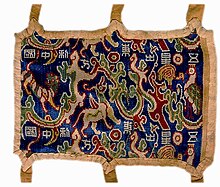
Performing arts
Main article: Sichuan opera Main article: Music of Sichuan Main article: Shu schoolClothing
Main article: Clothing in ancient ShuCuisine
Main article: Sichuan cuisineTea culture
Main article: Mengding Ganlu teaReligion
Main article: Religion in Sichuan See also: Christianity in Sichuan, Islam in Sichuan, and Zoroastrianism in SichuanOthers
Main article: Sichuanese medicine Main article: Mahjong Main article: Sichuan cliqueGallery
- Religious buildings
-
 Taoist temple of Huanglong
Taoist temple of Huanglong
-
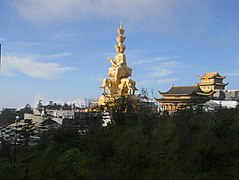 Golden Temple of Mount Emei of the Chinese Buddhist tradition
Golden Temple of Mount Emei of the Chinese Buddhist tradition
-
 Gonchen Monastery of the Tibetan Buddhist tradition
Gonchen Monastery of the Tibetan Buddhist tradition
-
Baba Mosque [zh], a Sufi mosque in Langzhong
-
 Immaculate Conception Cathedral, Chengdu (Catholic)
Immaculate Conception Cathedral, Chengdu (Catholic)
-
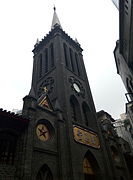 St. Joseph's Cathedral, Chongqing (Catholic)
St. Joseph's Cathedral, Chongqing (Catholic)
-
 Sï-Shen-Tsï Church (Methodist)
Sï-Shen-Tsï Church (Methodist)
-
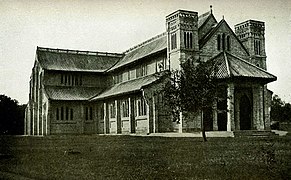 St John's Cathedral, Langzhong (Anglican)
St John's Cathedral, Langzhong (Anglican)
-
 Tongchuan Meeting House built in Western Sichuanese folk style (Quaker)
Tongchuan Meeting House built in Western Sichuanese folk style (Quaker)
See also
- Culture of Gansu
- Culture of Qinghai
- Culture of Tibet
- Culture of Yunnan
- Sichuanese people
- Pearl Temple
References
- Li, Hsing-jung; Fêng, Ming-i; Yü, Chih-yung (November 1, 2014). 導遊實訓課程 (in Traditional Chinese). Taipei: E-culture. p. 331. ISBN 9789865650346.
- Yan, Jie; Wang, Jun (2011). "Character and social interpretation of local architecture in the south of Shaanxi". Advanced Materials Research. 368–373: 3009. doi:10.4028/www.scientific.net/AMR.368-373.3006.
- Sage, Steven F. (1992). Ancient Sichuan and the Unification of China. Albany, New York: State University of New York Press. pp. 1–2. ISBN 9781438418469.
- ^ Claudia Michele Thompson (2000). Scripts, Signs, and Swords. University of Pennsylvania. p. 14.
- Zhao, Weijie (2021). "New archeological marvels of ancient Shu civilization". National Science Review. 8 (7): nwab071. doi:10.1093/nsr/nwab071. PMC 8310767. PMID 34691698. Archived from the original on April 18, 2024. Retrieved February 23, 2024.
- "Jinsha Site Museum". www.jinshasitemuseum.com. Archived from the original on April 18, 2024. Retrieved February 24, 2024.
- Liu, Hong (June 2006). "巴蜀文化渊源". huaxia.com (in Chinese). Archived from the original on May 2, 2019. Retrieved September 7, 2017.
- Liu, Hong. "巴族和蜀族怎樣構成巴蜀文化? | 中國文化研究院 - 燦爛的中國文明". chiculture.org.hk (in Chinese). Archived from the original on April 18, 2024. Retrieved April 18, 2024.
- Tan, Yihua (May 27, 2024). "协同保护巴蜀文化瑰宝,川渝携手为川剧保护传承立法_四川在线". sichuan.scol.com.cn (in Chinese). Archived from the original on June 17, 2024. Retrieved June 17, 2024.
- "用更多精品力作推动川剧振兴 促进巴蜀文化绽放新的时代光彩". sc.people.com.cn (in Chinese). November 30, 2023. Archived from the original on June 17, 2024. Retrieved June 17, 2024.
- "李后强丨川菜的文化基因与学理基础 -四川经济网-经济门户". www.scjjrb.com (in Chinese). Archived from the original on June 17, 2024. Retrieved June 17, 2024.
- Te Winkle, Kimberley S. (2005). "A Sacred Trinity: God, Mountain and Bird. Cultic Practices of the Bronze Age Chengdu Plain" (PDF). Sino-Platonic Papers (149): 13. ISSN 2157-9679. Retrieved October 22, 2024.
- Xiaoye (2021). "三千多年前三星堆人穿什么?" [What did Sanxingdui people wear three thousand years ago?]. 天府广记 (in Simplified Chinese). No. 3. Chengdu: Chengdu Committee of the Chinese People's Political Consultative Conference. Retrieved October 22, 2024.
- "【巴蜀文化】天府人间,辉映流光 - 青陇巴蜀 - 汗青网" (in Chinese). March 4, 2016. Archived from the original on March 4, 2016. Retrieved April 5, 2024.
- "Bronze sacred tree found in Sanxingdui sacrificial pit – The History Blog". September 9, 2021. Archived from the original on June 17, 2024. Retrieved April 5, 2024.
- "Newly found Chinese artifacts illuminate mysterious ancient kingdom". NBC News. June 15, 2022. Archived from the original on June 17, 2024. Retrieved April 5, 2024.
- Luo, Zhitian (March 29, 2023). "【资讯】浅析巴蜀文化". Chengdu University of Technology (in Chinese). Archived from the original on April 5, 2024.
- "Qin Dynasty: Achievements, Facts & Time Period". HISTORY. June 16, 2023. Archived from the original on June 17, 2024. Retrieved April 5, 2024.
- "巴文化的多元传播探究_光明日报_光明网". www.gmw.cn (in Chinese). October 27, 2004. Archived from the original on June 17, 2024. Retrieved April 12, 2024.
- "东西问丨巴文化何以成为中华文明的坚定"一元"?-中新网". www.chinanews.com.cn (in Chinese). May 14, 2022. Archived from the original on June 17, 2024. Retrieved April 12, 2024.
- Tang, Li (October 9, 2014). "巴文化传统符号与旅游工艺品设计的融合 -《装饰》杂志官方网站 - 关注中国本土设计的专业网站 www.izhsh.com.cn". www.izhsh.com.cn (in Chinese). Archived from the original on June 17, 2024. Retrieved April 12, 2024.
- "巴文化 | 巴、蜀、楚的文化关系,你知道吗?_巴楚". www.sohu.com (in Chinese). Archived from the original on June 17, 2024. Retrieved April 12, 2024.
- "巴渝舞:巴人啸聚山林的狂欢盛宴_巴中市人民政府". www.cnbz.gov.cn (in Chinese). Archived from the original on June 17, 2024. Retrieved April 12, 2024.
- "巴文化研究若干问题的思考 - 重庆考古". www.cqkaogu.com. Archived from the original on June 17, 2024. Retrieved April 12, 2024.
External links
| Sichuan topics | |||||
|---|---|---|---|---|---|
| Chengdu (capital) | |||||
| General | |||||
| History |
| ||||
| Geography | |||||
| Culture | |||||
| People | |||||
| Religion | |||||
| Languages |
| ||||
| Tourist attractions | |||||
| |||||
This article about Asian culture is a stub. You can help Misplaced Pages by expanding it. |

